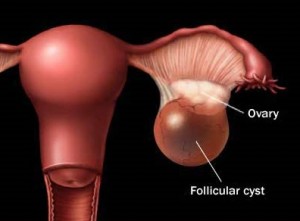More and more women are suffering from ovarian cyst. Ovarian cyst is characterized by a fluid-filled sac that grows in the ovaries most likely during ovulation. It could take the size of a bean or bigger than a baseball. Cyst in ovary is oftentimes harmless and disappears even without treatment. However, some cyst may bring trouble like pain, bleeding and rupturing and surgery is highly needed to eliminate the ovarian cyst. Here are some information you need to know about ovarian cyst.
Types of Ovarian Cysts
Ovarian cysts are of different types and each have respective manifestations. For instance, larger cysts also have various types. Follicular cysts are not painful and grow up to two inches while Dermoid cyst grows over six inches and characterized by severe pain. And lastly, Endometrioid cysts grow over eight inches and are painful especially during menstruation. In this regard, it is best to have the ovarian cyst examined by the physician to figure out the size of the growth. Although larger ovarian cysts are not permanent but quite painful, you should never ignore treating them once you have figured out its development because they are likely to rupture.
Symptoms and Diagnosis
There are obvious and hard-to-miss symptoms of cyst in ovary. It does have common symptoms which include pain during menstrual period, irregular menstrual periods, dull to sharp shooting pain and discomfort either at the lower back, abdomen or pelvis. pain or pressure is felt during bowel movement, unusual pain in the ribs, weight gain, headaches, increased hair growth level, pelvic pain after an exercise or sexual intercourse coupled with breast tenderness, vomiting and nausea. Hence, if you have experienced any of these symptoms and suspect it to be an ovarian cyst, seek medical advice to confirm its existence.
There are different ways in diagnosing the development of ovarian cysts. First is by annual pelvic examinations conducted by qualified physicians. During these check-ups, ovarian cysts can be
confirmed. However, if the physician was not able to confirm the cyst by this method, then, he or she will recommend other examinations, such as an ultrasound. Ultrasound works like taking a picture inside your ovaries and uterus and based on the picture, the doctor will be able to confirm and determine the existence and composition of the cyst as well as its location. Laparoscopy is another way of diagnosing ovarian cyst. In this method, the doctor uses a laparoscope, a maneuverable small camera that helps the physician have a detailed examination of the cyst. In fact, ovarian cyst can be removed immediately
during the examination.
Treatment for ovarian cysts
There are plenty of options you can try to treat ovarian cyst. One way is by natural home remedy. Living a healthy lifestyle is the primary step of eliminating ovarian cyst. It involves eating right, increasing your water and fiber intake and frequently relieving your bladder as soon as possible. These effectively ease the pain related to ovarian cyst. Another way of treating cyst in ovary is by taking prescribed medication. Surgery, on the other hand, is the last option for severe cases.
Prevention is your finest shield against developing cyst in ovary. Thus, be alert with any unusual changes you may observe and feel in your body and seek early treatment before it gets worse.
Ovarian Cyst Laparoscopy
Laparoscopy for ovarian cysts is possibly the last option to treat ovarian cysts that are not complex. The other treatment options for cyst in ovary include natural treatment, prescription hormones etc.
There are two reasons to do a laparoscopy for cyst in ovary
1. It is a minor surgical procedure and can be done on an outpatient basis through general anesthesia. You may have to fast 9 to 12 hours before the ovarian cyst surgery. If you eat, then you may feel nauseous. In the surgery, the surgeon makes a little incision below the belly button, inserts a needle and infuses carbon dioxide gas in the abdominal cavity. It is a harmless procedure, the intention is to lift the abdominal wall. Then an illuminated eaparascope along with a tiny camera is pushed in through the same incision. A second incision is also made at the lower and to the left or right (or even both sides) in the area where you may have the cyst. With the help of the laparascopic forceps, the cyst is removed but not before draining it. Stitches are done to close and you are kept in the operation room, till all your vital signs are stable.
Post operative pain associated with this ovarian cyst surgery is minimal. The carbon dioxide gas may give you some cramps in the abdomen but they recede in the next few days. The procedure is just 30 to 60 days, ovarian cyst laparoscopy is a minor procedure but being invasive, there are usual surgical risks like scarring below the bikini line and infection. You can discuss with your health care provider and find out the best treatment for ovarian cyst.
.

What causes ovary cystst? Heridetary or not? Any alternative or natural ovarian cysts treat?